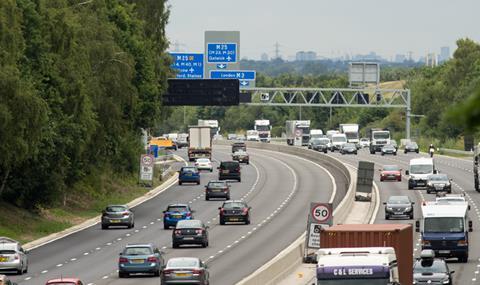
The House of Commons Transport Committee has renewed its call for longer and more frequent emergency refuge areas on all-lane running (ALR) schemes, after an AA survey revealed more than a fifth of drivers rate ALR motorways as dangerous.
The survey of 20,000 drivers, published this week, saw 22% of respondents identify ALR schemes as more dangerous than rural B roads (19%), which was second only in danger to unclassified narrow lanes (36%). Only 4% of respondents rated traditional motorways as dangerous.
In a statement this week Transport Committee chairwoman Lilian Greenwood MP said the survey “demonstrates that the public still has serious concerns about the safety of ALR schemes,” which she said present “a real challenge” for drivers.
Greenwood also criticised the results of a Highways England review into the safety of ALR schemes, which were revealed to the committee in a letter from Highways England chief Jim O’Sullivan earlier this month.
Measures include an increase in the frequency of ERAs on future schemes from the current 1.5 miles to one mile and the installation of a “ small number” of additional ERAs on ALR schemes “with the highest level of potential live stops”. However the review rejected calls for longer ERAs, which O’Sullivan told the committee are “sufficient for safe vehicle recovery”.
Greenwood said: “One area of particular concern is the size and spacing of Emergency Refuge Areas. Plans to reduce the spacing to one mile between the refuge areas in future schemes falls far short of the committee's recommendation that the areas should be spaced at 500-800 metres apart, as in the M42 Active Traffic Management pilot ,which the committee supported.”
Read More
- AA says smart motorway fines should be reinvested to improve network’s safety
- Transport Committee accuses DfT of “blatantly ignoring” all-lane running safety fears
- Highways England will transform the nation’s roads
“This AA survey shows qualified support from the public for refuge areas spaced one kilometre apart (0.6 miles). I would urge Highways England to review this decision.”
Announcing the AA survey results this week AA president Edmund King said driver safety was being compromised by the removal of the hard shoulder. He also questioned the reduction of ERA frequency to one mile.
He said: “There is still some way to go to convincing drivers that a mile is a distance they can cover with an ailing vehicle. More than half of drivers (55%) say that, faced with their vehicle breaking down, they are only prepared to drive up to half a mile before stopping in a live lane.”
Red X penalties shortly in the post
Highways England is set to introduce fines as early as March for drivers who ignore the Red-X signals on Smart Motorways.
Documents seen by the press association reveal the agency is trialling roadside cameras aimed at detecting drivers that ignore Red-X signs. Drivers are expected to face a similar penalty to that handed out for running a red light – £100 and three penalty points.
The move follows a concerted education campaign and the sending of thousands of warning letters to non-compliant drivers which has reduced the number of drivers ignoring lane closures, according to Highways England.
Transport Committee chairwoman Lilian Greenwood said: “While there has been some success with reducing levels of non-compliance with red-x signals, this work needs to continue apace. We will continue to monitor this and look forward to further updates from Highways England."
Main Image: PA Images














